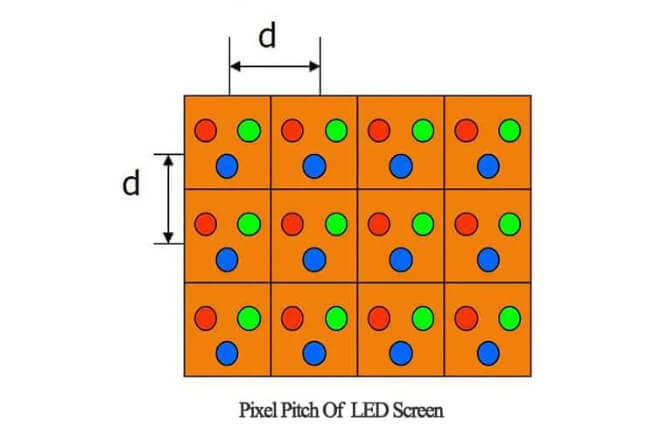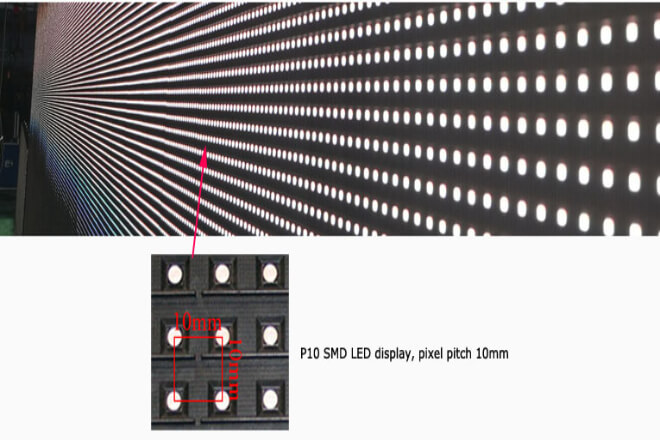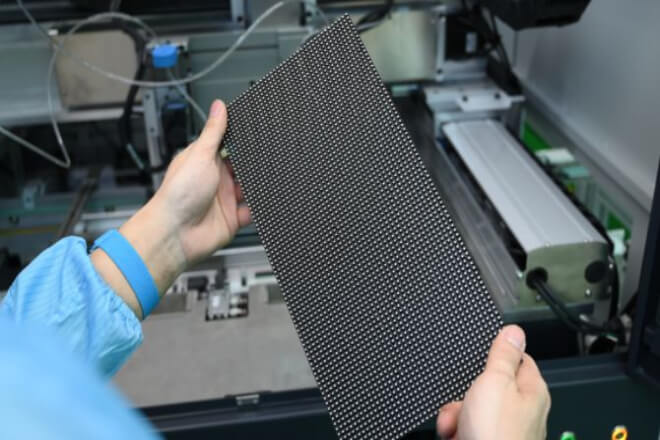مقدمة

Have you ever been confused when buying an عرض الصمام? Faced with a variety of dot pitch specifications, do you not know how to choose?
What exactly is dot pitch? How much impact does it have on the LED display? What problems will the wrong dot pitch bring?
Today, let us explore these issues in depth to help you make a more informed choice.
جدول المحتويات
1. What is the dot pitch of the LED display?

Imagine that there is an LED display in front of you with densely packed small dots on it. These small dots are pixels.
The dot pitch is the distance between the centers of two adjacent pixels. The smaller the dot pitch, the denser the pixels, and the more delicate the picture looks.
2.1). P1.2:
The dot pitch is 1.2 mm. This display has a high pixel density, just like squeezing a lot of small dots together, so the picture is particularly clear.
It is suitable for places with high requirements for picture quality, such as studios and high-end conference rooms. Even if you look at it from a close distance, the picture will not look grainy.
2.2). P2.5:
The dot pitch is 2.5 mm. This display has a lower pixel density than P1.2, but it is cost-effective.
Suitable for scenes with medium-distance viewing, such as commercial advertising screens and medium-sized conference rooms.
The picture effect is also good when viewed from a suitable distance.
2.3). P4:
The dot pitch is 4 mm. The pixel density is relatively low, but the cost is also low. Suitable for long-distance viewing, such as outdoor advertising screens and الملاعب.
Because the audience is far away from the screen, the picture will not look grainy.
1). The relationship with دقة
In simple terms, the smaller the dot pitch, the higher the resolution. Just like on a screen of a fixed size, the smaller the dot pitch, the more pixels can be accommodated, and the richer the picture details.
For example, for the same size screen, the P1.2 display can display much more detail than the P4, just like the photos taken by a high-pixel camera are clearer than those taken by a low-pixel camera.
2). Relationship with عرض المسافة
When viewed from a close distance, the screen with a large dot pitch will look rough, like a mosaic. For example, if you are too close to a P4 screen, you will see small dots.
However, the P1.2 screen still looks very delicate when viewed from a close distance.
When viewed from a distance, a screen with a large dot pitch can also be used, because the human eye cannot see small dots clearly at a distance, and the picture looks more natural.
Generally speaking, the best viewing distance can be estimated by multiplying the dot pitch by 1000. For example, for a P2.5 screen, the best viewing distance is about 2.5 meters.
Impact 1: Blurred image quality and unclear display of the LED display

Have you ever encountered this situation? You are standing in front of an LED display, and the picture on the screen looks foggy and not clear at all.
As if there is a layer of frosted glass between it. This is the problem of blurred image quality and unclear display.
This situation is really a headache, especially when you want to see the content on the screen clearly, such as watching a presentation in a conference room or watching an advertising video in a shopping mall.
1). The image is grainy due to low دقة
Why does this problem occur? The main reason is that the screen resolution is too low. You can think of resolution as the number of “dots” on the screen.
These “dots” are pixels, which combine to form the picture we see.
If there are too few pixels, the picture will become rough, just like painting on a canvas with a large brush, and the details will definitely not be drawn.
On the contrary, if there are many pixels, the picture will be very delicate, just like painting with a very fine brush, and many details can be drawn.
When the resolution is low, the image on the screen will appear grainy. This graininess is like magnifying a photo many times, and the lines and colors that should have been smooth have become small squares.
In this case, it is difficult to restore the details of the picture. For example, you see a photo of a person on an advertising screen.
If the screen resolution is low, you may only see a blurred outline, and you can’t see the person’s expression and details at all.
It’s like you are holding a magnifying glass to look at a low-quality printed photo. After magnification, it is full of small dots, and you can’t see the content at all.
2). Details cannot be restored, affecting the viewing experience
This situation, where details cannot be restored, will really greatly affect your viewing experience.
Imagine that you are watching an important speech in a studio, and the expressions of the characters on the screen are blurred, and the text is not clear. Would you feel annoyed?
Or you see an advertising screen in a shopping mall, and the product details on it are not clear. Will you still be interested in this product?
The answer is definitely not. This blurred picture will make people feel that the screen quality is very poor, and even affect your perception of the entire scene.
3). Especially when watching at close range
Moreover, this situation will become more obvious when watching at close range.
For example, you are in a conference room, only two or three meters away from the screen. If the dot pitch of the screen is too large, you will see obvious graininess.
This graininess is like small light bulbs on the screen. You can see their shapes clearly. How can the picture be clear?
On the contrary, if the dot pitch of the screen is small and the pixels are dense, even if you are very close, the picture will look very delicate.
Just like when you look at photos with a high-definition mobile phone, the details can be seen clearly.
Therefore, if you are choosing an LED display, you must pay attention to the dot pitch and resolution.
Although the price of a screen with a small dot pitch and high resolution may be a little more expensive, it is definitely worth investing in because it can give you a better visual experience.
Impact 2: Serious waste of purchase cost or budget overrun

Have you ever encountered this situation? The budget was limited and I wanted to buy an LED display.
But I chose a screen with a too small dot pitch, the price went up all of a sudden, and the budget was directly overrun.
This situation is really a headache. Not only does it waste money, but it may also affect the original project plan.
1). Too small dot pitch = a sharp increase in price
The smaller the dot pitch, the higher the pixel density of the screen, which means that the manufacturing cost of the screen will also increase significantly.
It’s like when you buy a piece of clothing, the more fabric you use, the more expensive it will be.
Similarly, the smaller the dot pitch, the more LED beads on the screen, and the more complicated the manufacturing process, so the price will rise sharply.
For example, a P1.2 screen may cost several times or even more than a P4 screen. This price gap is particularly obvious on large-size screens, which can easily exceed the budget.
2). “Over-specified” when not in line with actual needs, low cost-effectiveness
Many times, we may be misled by some sales staff, or our own assessment of needs is not accurate enough, and we end up choosing a screen with too small a pitch.
In this case, although the screen looks “high-end”, it may not actually meet actual needs.
For example, in an outdoor advertising screen project, the audience is far away from the screen, and a P4 screen is actually enough, but you chose a P1.2 screen.
This “over-specification” not only wastes money but also reduces the cost-effectiveness of the project.
3). Projects with limited budgets may be stranded or scaled down
For projects with limited budgets, this overspending situation may cause the project to be stranded or scaled down.
For example, you originally planned to install several LED screens in a shopping mall to display advertisements and promotional information.
However, because you chose a screen with too small a pitch, the price exceeded the budget, and you may have to reduce the number of screens installed, or simply give up the project.
This not only affects the implementation of the project, but may also affect your business plan and revenue.
Impact 3: The viewing comfort of LED display screens decreases

1). Too large dot pitch: glare and fatigue when viewed from close range
Imagine that you are standing in front of an LED display screen with a large dot pitch, such as a P4 or larger screen.
When you get close to the screen, you will see obvious pixels, and the light emitted by these pixels is very dazzling.
This glaring light will make people’s eyes feel uncomfortable and even cause eye fatigue. It’s like staring at a very bright light, and your eyes will not be able to bear it for a long time.
In this case, the audience will not only not be able to see the content of the picture clearly, but may also reduce the viewing time due to eye discomfort, affecting the viewing experience.
2). Too small dot pitch:
No advantage in long-distance viewing, but a waste of resources
On the contrary, if the dot pitch is too small, such as P1.2 or even smaller, although the picture is very clear when viewed from a close distance, the advantage of high resolution will not be reflected when viewed from a distance.
For example, in an outdoor advertising screen scene, the audience may be dozens of meters away from the screen.
In this case, the P1.2 screen and the P4 screen look similar because the human eye cannot distinguish such small pixels at a distance.
Moreover, using a screen with too small a dot pitch will increase costs, including purchase costs and maintenance costs, which is equivalent to wasting resources.
3). Poor user experience for long-term viewers
Whether the dot pitch is too large or too small, it will affect the user experience of long-term viewers.
If the screen is glaring, the audience will quickly feel uncomfortable and may even leave.
If the screen resolution is too high but has no practical advantages, it will also make people feel that it is not worth it.
For example, in a conference room, if the dot pitch of the screen is not appropriate, the audience may not be able to concentrate due to eye fatigue, affecting the meeting’s effect.
In a commercial display, if the audience reduces their stay time due to screen problems, it will also affect the advertising effect and brand image.
Impact 4: Maintenance and operation problems that may be brought about later

1). High screen temperature and high power consumption (especially high-density screens)
Have you ever wondered why high-density LED displays feel particularly “hot” when used?
This is because the more LED beads on the screen, the greater the heat generated when working.
It’s like if you turn on a lot of lights in a room, it will definitely be much hotter than just one or two lights. High-density LED display screens, such as P1.2 or even smaller dot pitch screens.
Because the lamp beads are dense, not only is the temperature high when working, but also the power consumption is very large.
This means that you need more electricity to keep the screen running, and the electricity bill will naturally go up.
2). More frequent maintenance, more complex control system
High-density screens are not only high in temperature and power consumption, but also more troublesome to repair.
Because there are many lamp beads, any problem with any lamp bead may affect the display effect of the picture.
This requires more frequent inspections and repairs, and the difficulty of repair is also greater.
For example, you may need professional technicians to detect and replace broken lamp beads, which not only increases the maintenance cost, but may also affect normal use due to the long maintenance time.
Moreover, the control system of high-density screens is also more complex. The screen requires more sophisticated control to ensure that each lamp bead can work properly, which requires more advanced control equipment and software.
This complex control system not only increases the initial investment, but also may cause the screen to not work properly due to system failure, further increasing the difficulty and cost of maintenance.
3). Rising operating costs in the later stage
These high initial investments and complex maintenance requirements will eventually lead to rising operating costs in the later stage.
In addition to the electricity and maintenance costs mentioned above, there may also be downtime losses caused by screen failures.
For example, in a commercial advertising screen, if the screen is shut down due to maintenance, it may miss important advertising time slots and affect advertising revenue.
In some important occasions, such as large-scale events or conferences, the downtime of the screen may even bring greater economic losses and reputation damage.
6. الخاتمة
Through the above content, we have discussed in detail the selection of LED display screen dot pitch and its possible impact.
I hope this information can help you be more handy when purchasing LED display screens.
وأخيرًا، إذا كنت تريد معرفة المزيد عن شاشات العرض LED، يرجى الحصول على اتصال معنا.
